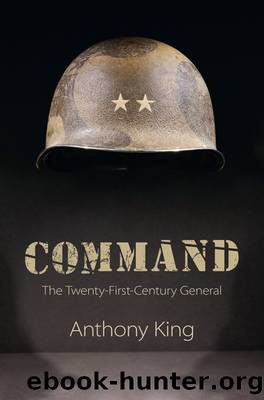Command by King Anthony

Author:King, Anthony
Language: eng
Format: epub
Publisher: Cambridge University Press
Published: 2018-11-08T00:00:00+00:00
The flag officers formed themselves into a command federation around Nick Carter, assisting him with decision-making and the management of Moshtarak.
It is possible to delineate the responsibilities of the flag officers more precisely here. Dickie Davis, the Chief of Staff, ran the headquarters; Tom Murray, a US Marine brigadier, was the deputy commander. Ben Hodges became Deputy Chief of Staff-Operations, responsible for current and future operations (the J3/5 and J3 branches), Craig King (Canadian Army brigadier) commanded Plans and Policy (J5) and Emile van Duren, a Dutch air force officer, was responsible for the logistics of national support elements. Each of these deputies had a very large staff, for whom they were responsible. However, the Deputies were not primarily engaged with organizing their respective staffs as branch chiefs. In each branch, full colonels provided that function. Rather, the deputies pointedly acted as proxies for Nick Carter himself. The flag officers were not simply Carterâs aides or representatives, they became active agents for him exercising decision-making authority in specified areas: âThere was no doubt about it: Nick Carter was the boss. We were his disciplesâ.31
Having been inducted into the planning process early, especially through the dissemination of the schematic, Carterâs deputies understood intimately what their commander wanted. However, they did not simply support Nick Carter, relieving him of administrative burden. They assumed significant executive authority to ensure that the operation progressed. They acted for him â or rather as him â when he was not present: âNick Carter spent loads of time on the ground. But when you added up where Nick Carter was to be on any day, he could have reasonably been in four of five places. When Nick Carter was struggling for time, he would use Tom [Murray] and Ben [Hodges] so that he could turn into three peopleâ.32 While Carter was pre-occupied with oblique diplomatic management, his deputies increased his capacity to make timely decisions.
In the quotation above, Chief of Staff, Dickie Davis, noted the role which Ben Hodges and Tom Murray played in multiplying Nick Carterâs authority, acting as substitutes for him. It is worth exploring how they did this in greater detail. Tom Murray, the deputy commander, for instance, stood in regularly for Carter in meetings in the Headquarters and often represented Carter on video-tele conferences to subordinate and superior headquarters; âif Nick Carter needed to be in ISAF, Tom Murray would do thatâ.33 However, Murray played a more important role than simply sitting in for Carter in meetings: âThe Deputy Commander, Tom Murray, was the stay-at-home guy. He had decision authority. For instance, SOF hit targets every night and that would require approval. He would approve at 0100am. Having a US officer doing this was helpful because it would mainly be US SOF [Special Operations Forces]â.34 This is a significant observation in understanding how Moshtarak was managed. Special Operations Forces raids were a very important and highly sensitive part of the campaign and the decision to launch one was, perhaps, the most tactically significant decision a commander could make.
Download
This site does not store any files on its server. We only index and link to content provided by other sites. Please contact the content providers to delete copyright contents if any and email us, we'll remove relevant links or contents immediately.
| Africa | Americas |
| Arctic & Antarctica | Asia |
| Australia & Oceania | Europe |
| Middle East | Russia |
| United States | World |
| Ancient Civilizations | Military |
| Historical Study & Educational Resources |
The Light of Days by Judy Batalion(1081)
First Platoon: A Story of Modern War in the Age of Identity Dominance by Annie Jacobsen(924)
Stalin's War: A New History of World War II by Sean McMeekin(870)
The Pacific War 1941-1943 by James Holland(813)
Walk in My Combat Boots by James Patterson(773)
The American War in Afghanistan by Carter Malkasian(753)
Victory's Price (Star Wars) by Alexander Freed(741)
The Vietnam War: An Intimate History by Geoffrey C. Ward & Ken Burns(736)
Blood and Ruins: The Great Imperial War, 1931-1945 by Richard Overy(696)
Operation Pedestal by Max Hastings(691)
Concepts of Space by Jammer Max;(678)
Cold War (Alexander King Book 2) by Bradley Wright(673)
Extreme Fitness by Chris McNab(665)
The Madman Theory by Jim Sciutto(661)
Flying Tiger by Samson Jack(647)
World War II Infantry Fire Support Tactics by Gordon L. Rottman(622)
Pathfinders by AL-KHALILI JIM(620)
Panzerkrieg by Mike Syron(607)
Bismarck by Jean-Paul Bled(603)
